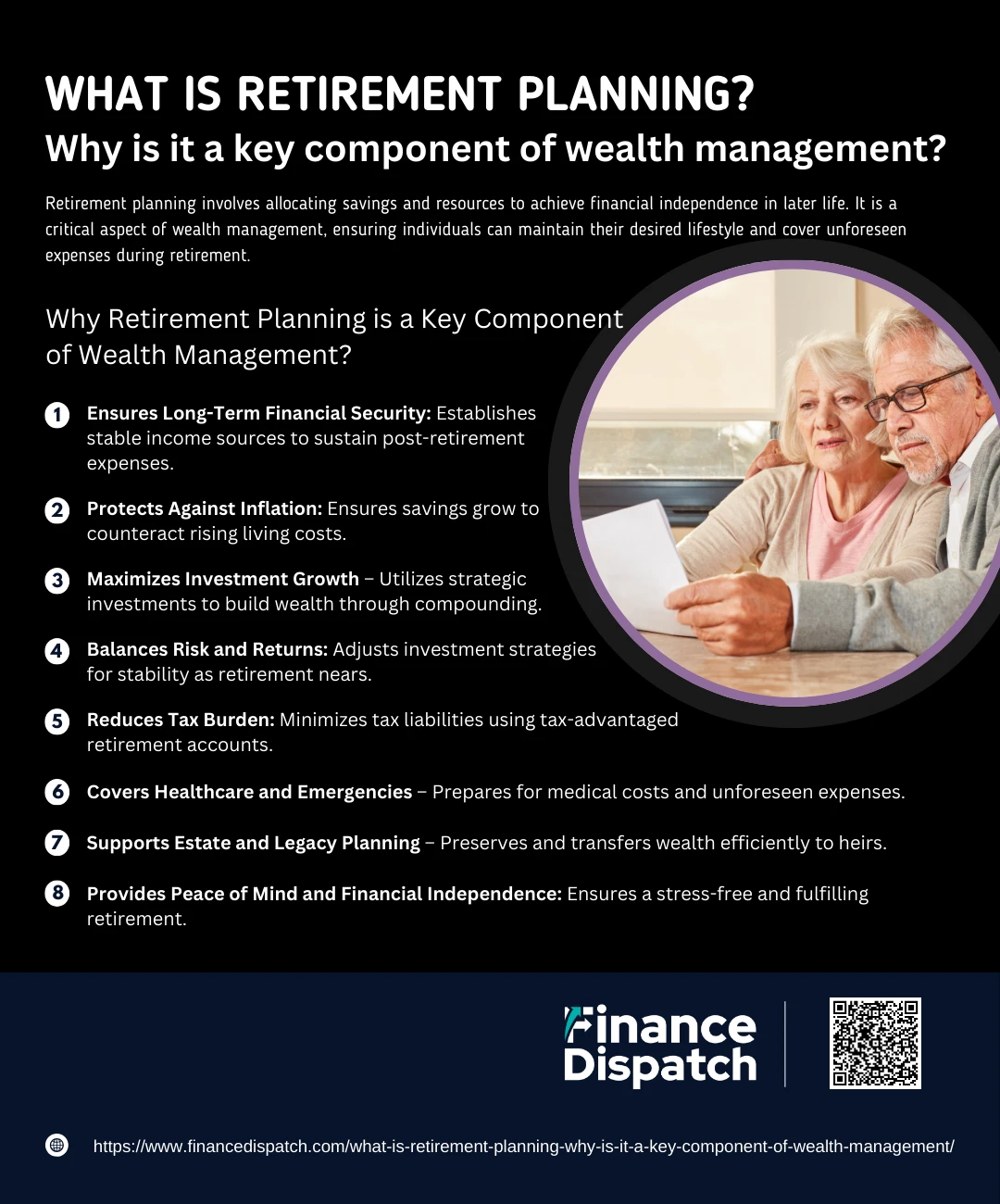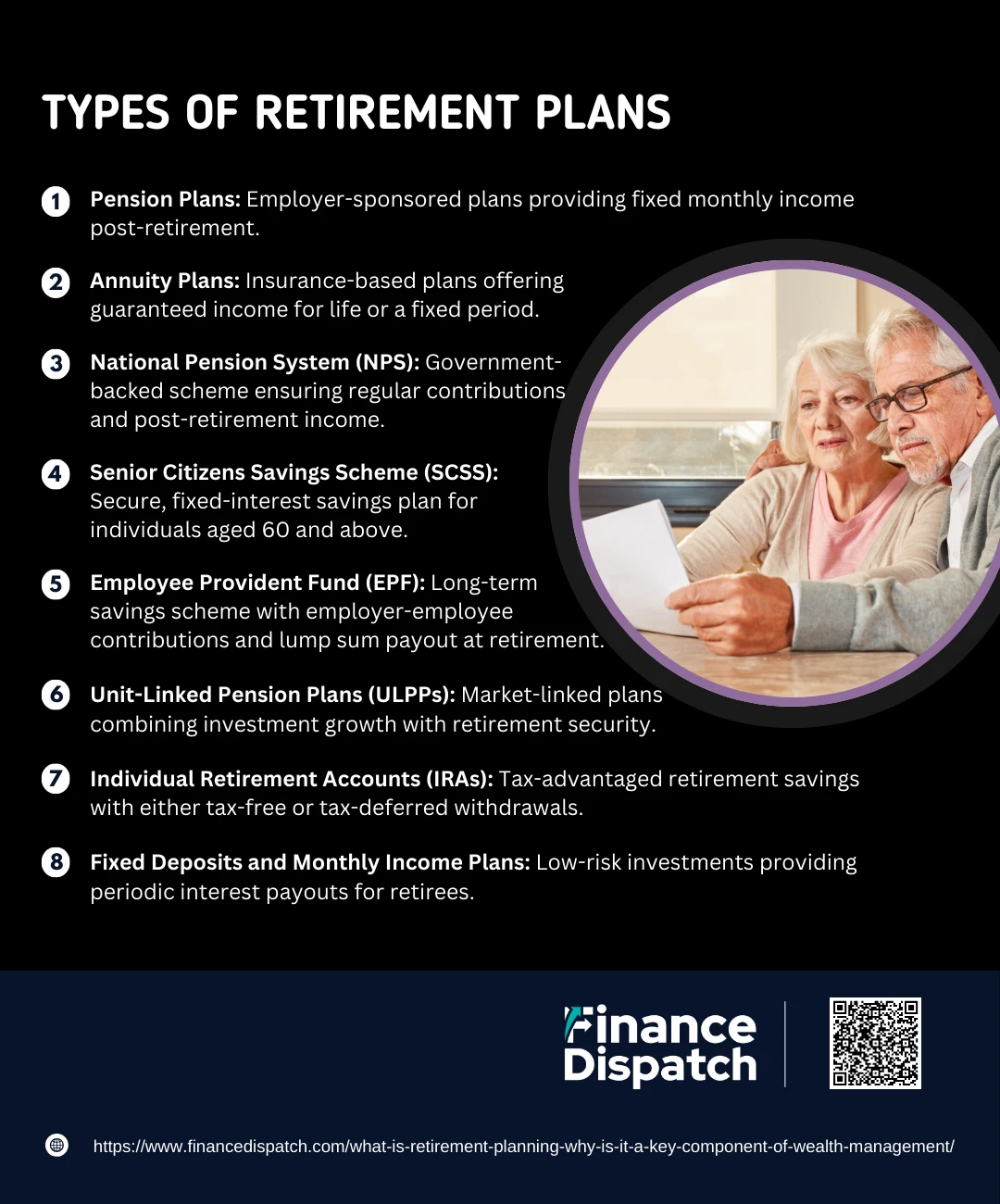Retirement planning is more than just setting aside money for the future—it is a strategic financial process that ensures you can maintain your desired lifestyle and financial independence long after you stop working. As life expectancy increases and the cost of living rises, securing a stable post-retirement income has become more crucial than ever. Retirement planning is not just about saving but also about making informed investment decisions, managing risks, and ensuring financial security throughout your golden years. It is a fundamental aspect of wealth management, as it involves structuring your assets, optimizing tax benefits, and safeguarding your financial future. By integrating retirement planning into a comprehensive wealth management strategy, individuals can achieve long-term financial stability, protect their wealth, and create a legacy for future generations.
What is Retirement Planning?
Retirement planning is the process of systematically preparing for financial security in your post-working years. It involves assessing your future financial needs, setting savings goals, and choosing the right investment strategies to ensure a steady income after retirement. Beyond just accumulating wealth, retirement planning takes into account inflation, healthcare costs, and lifestyle aspirations to create a sustainable financial roadmap. This process includes contributing to pension funds, investing in diversified assets, and managing risks to build a reliable corpus. A well-structured retirement plan not only helps maintain your standard of living but also ensures financial independence, reducing reliance on family or government support. By planning early and making informed financial decisions, individuals can enjoy a comfortable and stress-free retirement while safeguarding their wealth for the future.
The Connection between Retirement Planning and Wealth Management
Retirement planning and wealth management go hand in hand, as both focus on building, preserving, and strategically utilizing financial resources for long-term security. While retirement planning specifically aims to ensure financial independence in later years, wealth management provides a broader framework that includes investment strategies, risk assessment, tax efficiency, and estate planning. A well-structured wealth management approach helps individuals allocate assets wisely, balancing growth and stability to sustain a comfortable retirement. Additionally, tax-advantaged retirement accounts, diversified investments, and insurance planning play a crucial role in safeguarding wealth against inflation, market volatility, and unforeseen expenses. By integrating retirement planning into a comprehensive wealth management strategy, individuals can not only secure their financial future but also optimize their resources to leave a lasting legacy for future generations.
 Why Retirement Planning is a Key Component of Wealth Management?
Why Retirement Planning is a Key Component of Wealth Management?
Retirement planning is an essential pillar of wealth management because it ensures long-term financial security, allowing individuals to maintain their desired lifestyle even after they stop earning a regular income. Without a structured retirement plan, even substantial wealth can be depleted due to rising living costs, healthcare expenses, market volatility, and poor financial decisions. Effective wealth management incorporates retirement planning to ensure that savings and investments are allocated efficiently, risks are minimized, and income streams are sustainable. A well-structured retirement strategy not only protects wealth but also helps individuals achieve financial independence, reduce tax liabilities, and leave a legacy for future generations. Below are key reasons why retirement planning plays a crucial role in wealth management:
1. Ensures Long-Term Financial Security
Retirement planning helps create a stable and reliable income source for post-retirement years. Through a mix of investments, pension funds, and savings, individuals can ensure they have sufficient funds to cover their expenses without financial stress or dependency on others.
2. Protects Against Inflation
Inflation gradually reduces the purchasing power of money. What seems like an adequate amount today may not be sufficient in the future. A well-planned retirement strategy considers inflation-adjusted returns, ensuring that savings grow over time to keep up with increasing costs.
3. Maximizes Investment Growth
Retirement planning allows individuals to strategically invest in different asset classes, including stocks, bonds, mutual funds, and annuities. A long-term investment approach, when integrated into wealth management, helps build a substantial retirement corpus through compounding returns.
4. Balances Risk and Returns
Wealth management involves optimizing the balance between risk and reward. As individuals approach retirement, their investment strategies must shift towards lower-risk options that provide stability while still offering reasonable returns. A diversified portfolio ensures that wealth is not eroded due to market fluctuations.
5. Reduces Tax Burden
Strategic retirement planning helps minimize tax liabilities by taking advantage of tax-advantaged retirement accounts, such as pension schemes, annuities, and retirement funds. Proper tax planning ensures that individuals can retain more of their savings while legally reducing their tax obligations.
6. Covers Healthcare and Emergencies
Healthcare costs tend to increase with age, and unexpected medical emergencies can quickly drain savings. Retirement planning includes provisions for medical insurance and emergency funds to cover healthcare expenses without affecting long-term financial stability.
7. Supports Estate and Legacy Planning
A comprehensive retirement plan aligns with estate planning to ensure that wealth is preserved and efficiently transferred to heirs. This involves setting up trusts, wills, and investment plans to ensure a smooth transition of assets while minimizing inheritance tax burdens.
8. Provides Peace of Mind and Financial Independence
One of the most significant benefits of retirement planning is the peace of mind it brings. Knowing that financial needs are covered allows individuals to enjoy their golden years without stress. Whether it’s traveling, pursuing hobbies, or spending time with family, financial stability enables a fulfilling retirement.
Why is Retirement Planning Important?
Retirement planning is essential because it provides financial security, stability, and independence in your post-working years. Without a structured plan, you risk outliving your savings, struggling with rising living costs, or becoming financially dependent on others. Proper retirement planning ensures that you have sufficient funds to cover daily expenses, healthcare costs, and unexpected emergencies while maintaining your desired lifestyle. Additionally, inflation can erode the purchasing power of money over time, making it crucial to invest in assets that grow and sustain wealth. A well-thought-out retirement plan also minimizes tax burdens and aligns with estate planning, allowing you to leave a financial legacy for your loved ones. Ultimately, retirement planning is about achieving peace of mind, knowing that you can enjoy your golden years without financial worries.
 Types of Retirement Plans
Types of Retirement Plans
Retirement plans come in various forms, each designed to help individuals secure their financial future after they stop working. These plans provide different investment opportunities, tax benefits, and payout structures to ensure a steady income post-retirement. The right plan depends on factors such as risk tolerance, financial goals, and the time left until retirement. Below are some common types of retirement plans that individuals can consider:
1. Pension Plans
These employer-sponsored plans provide a fixed monthly income post-retirement. Contributions are made by employers (sometimes with employee participation), and the payout is based on years of service and salary history.
2. Annuity Plans
Annuities are insurance-based retirement plans where individuals invest a lump sum or make periodic payments to receive guaranteed income for life or a specific period after retirement. They can be either immediate annuities (payouts start soon after investment) or deferred annuities (payouts start after a pre-decided period).
3. National Pension System (NPS)
A government-backed pension plan that allows individuals to contribute regularly during their working years and withdraw a portion as a lump sum at retirement while using the remaining funds to purchase an annuity for lifelong income.
4. Senior Citizens Savings Scheme (SCSS)
A secure, government-sponsored savings scheme for individuals aged 60 and above, offering fixed interest rates and periodic payouts to provide financial stability in retirement.
5. Employee Provident Fund (EPF)
A long-term savings scheme where both employer and employee contribute a fixed percentage of the salary. The accumulated funds, along with interest, are available at retirement, providing a lump sum financial cushion.
6. Unit-Linked Pension Plans (ULPPs)
These are market-linked retirement plans that allow individuals to invest in equity or debt funds, offering the potential for higher returns. They combine investment growth with retirement security.
7. Individual Retirement Accounts (IRAs)
In some countries, IRAs offer tax-advantaged savings for retirement, allowing individuals to contribute regularly and withdraw funds at a later stage, either tax-free (Roth IRA) or tax-deferred (Traditional IRA).
8. Fixed Deposits and Monthly Income Plans
Some retirees prefer low-risk investment options like fixed deposits (FDs) and monthly income plans (MIPs) offered by banks and financial institutions, which provide periodic interest payouts to supplement retirement income.
Key Components of Retirement Planning
Retirement planning is a multi-faceted process that involves careful financial management to ensure a secure and comfortable post-retirement life. It goes beyond just saving money—it requires setting clear financial goals, choosing the right investment strategies, managing risks, and preparing for future expenses. A well-structured retirement plan considers various factors such as income sources, inflation, healthcare costs, and estate planning. Below is a breakdown of the key components of effective retirement planning:
Table: Key Components of Retirement Planning
| Component | Description |
| Retirement Goal Setting | Defining financial goals, desired retirement age, and lifestyle expectations. |
| Savings & Investments | Regular contributions to pension plans, mutual funds, and diversified portfolios. |
| Income Planning | Estimating post-retirement income from savings, pensions, and annuities. |
| Risk Management | Balancing high-return investments with stable, low-risk options to protect assets. |
| Inflation Protection | Ensuring investments grow at a rate that outpaces inflation to maintain purchasing power. |
| Healthcare Planning | Setting aside funds for medical expenses and securing health insurance coverage. |
| Emergency Fund | Maintaining a reserve to cover unexpected financial emergencies without affecting retirement savings. |
| Tax Planning | Utilizing tax-efficient investment options to minimize tax liabilities on retirement income. |
| Estate Planning | Structuring wills, trusts, and asset distribution to ensure a smooth wealth transfer to beneficiaries. |
| Regular Portfolio Review | Periodically assessing and adjusting investments to align with changing financial goals and market conditions. |
Common Mistakes in Retirement Planning and How to Avoid Them
Retirement planning is a long-term financial commitment, and even small mistakes can significantly impact your post-retirement lifestyle. Many individuals either delay saving, underestimate expenses, or fail to diversify their investments, leading to financial insecurity in later years. A well-thought-out strategy can help avoid these pitfalls and ensure a comfortable retirement. Below are some of the most common retirement planning mistakes and ways to avoid them:
1. Delaying Retirement Savings
Mistake: Many people wait too long to start saving for retirement, thinking they have plenty of time. This reduces the power of compounding.
How to Avoid: Start as early as possible, even with small contributions, to maximize long-term growth.
2. Underestimating Retirement Expenses
Mistake: Some individuals fail to account for inflation, healthcare costs, and lifestyle changes, leading to financial shortfalls.
How to Avoid: Estimate your future expenses realistically, considering inflation and unexpected medical costs.
3. Not Having a Diversified Investment Portfolio
Mistake: Relying too much on one type of investment, such as fixed deposits or stocks, increases risk.
How to Avoid: Diversify investments across different asset classes, such as mutual funds, pension schemes, and real estate, to balance risk and returns.
4. Ignoring Inflation’s Impact
Mistake: Many retirees fail to consider how inflation erodes the purchasing power of their savings.
How to Avoid: Invest in inflation-protected assets, such as stocks, real estate, or inflation-indexed bonds.
5. Neglecting Healthcare Planning
Mistake: Overlooking medical expenses can deplete savings faster than expected.
How to Avoid: Secure adequate health insurance and maintain a medical emergency fund.
6. Carrying Debt into Retirement
Mistake: Entering retirement with outstanding loans or credit card debt can put financial strain on limited income.
How to Avoid: Pay off high-interest debts before retiring and avoid unnecessary borrowing.
7. Not Adjusting Investments Closer to Retirement
Mistake: Keeping a high-risk investment portfolio even as retirement approaches can lead to losses in a market downturn.
How to Avoid: Gradually shift to more stable investments, such as bonds and annuities, as retirement nears.
8. Failing to Account for Longevity
Mistake: Many individuals underestimate how long they will live, leading to insufficient savings.
How to Avoid: Plan for at least 25–30 years of post-retirement expenses to ensure lifelong financial stability.
9. Not Reviewing and Updating the Retirement Plan
Mistake: A static retirement plan can become outdated due to changes in income, expenses, and market conditions.
How to Avoid: Review and adjust your plan regularly to stay on track with your financial goals.
10. Overlooking Tax Planning
Mistake: Poor tax planning can result in higher tax liabilities on retirement income, reducing net savings.
How to Avoid: Utilize tax-efficient retirement plans and withdrawal strategies to minimize taxes.
 How to Start Your Retirement Planning?
How to Start Your Retirement Planning?
Retirement planning is essential for ensuring financial security and maintaining your desired lifestyle after you stop working. Many people postpone planning for retirement, assuming they have plenty of time. However, the earlier you start, the easier it is to build a sufficient corpus through systematic savings and smart investments. A well-structured retirement plan considers multiple factors, including inflation, healthcare costs, investment growth, and tax efficiency. Whether you are in your 20s, 30s, or even 50s, taking proactive steps now can set you up for a comfortable and financially independent retirement. Below are the key steps to starting your retirement planning:
1. Determine Your Retirement Age
Deciding when you want to retire is the foundation of your retirement plan. If you aim to retire at 60, you have more time to save and invest compared to someone planning to retire at 50. The earlier you start saving, the more time your investments have to grow.
2. Define Your Retirement Goals
Think about what you want your retirement to look like. Do you plan to travel frequently? Buy a vacation home? Pursue hobbies? Support your family? Understanding your post-retirement lifestyle will help you estimate how much money you need.
3. Estimate Your Post-Retirement Expenses
Your expenses may change after retirement. While you might save on commuting and work-related expenses, healthcare and leisure activities could cost more. Factor in regular living costs, inflation, and potential medical expenses to determine how much you need per month in retirement.
4. Assess Your Current Financial Position
Evaluate your existing savings, assets, and investments. This will help you determine how much more you need to save to reach your retirement goal. If there’s a gap, consider increasing your savings rate or adjusting your investment strategy.
5. Choose the Right Investment Options
A well-diversified portfolio ensures steady growth and protects against financial risks. Consider investing in:
- Mutual Funds & Stocks: Higher risk but higher long-term returns.
- Bonds & Fixed Deposits: Low risk, providing stable returns.
- Pension & Retirement Funds: Employer-sponsored plans or individual pension schemes.
- Real Estate & Annuities: Alternative investment options for passive income.
6. Open a Retirement Savings Account
If you haven’t already, enroll in a pension plan or a retirement savings account such as:
- National Pension System (NPS) – Market-linked returns with tax benefits.
- Employee Provident Fund (EPF) – Employer and employee contributions for retirement savings.
- Individual Retirement Accounts (IRAs) – Tax-advantaged investment options.
7. Plan for Healthcare and Emergencies
Medical expenses tend to rise with age. Ensure you have sufficient health insurance coverage before retirement, as premiums become costlier as you get older. Additionally, build an emergency fund with at least 6–12 months’ worth of expenses to handle unexpected situations.
8. Minimize Debt Before Retirement
Entering retirement with outstanding loans or credit card debt can drain your savings quickly. Pay off mortgages, personal loans, and high-interest debt before retiring to reduce financial stress.
9. Consider Tax Implications
Different retirement income sources have different tax treatments. Some pension plans and investments offer tax benefits, while others might be taxable upon withdrawal. Planning for tax-efficient withdrawals can help maximize your savings.
10. Regularly Review and Adjust Your Plan
Retirement planning is not a one-time activity—it requires periodic reviews and adjustments. Life circumstances, market conditions, inflation, and personal goals may change, requiring you to reassess your strategy and make necessary modifications.
The Role of Professional Financial Advisors in Retirement Planning
Professional financial advisors play a crucial role in retirement planning by helping individuals create a structured and effective financial strategy tailored to their long-term goals. They provide expert guidance on savings plans, investment options, risk management, and tax-efficient strategies to ensure a secure retirement. Financial advisors assess an individual’s financial health, estimate future expenses, and recommend suitable investment vehicles such as pension plans, annuities, and diversified portfolios. Additionally, they help retirees plan systematic withdrawals to sustain their lifestyle while minimizing tax liabilities. With changing market conditions, inflation, and evolving financial needs, financial advisors provide ongoing support and periodic reviews to adjust strategies accordingly. Their expertise helps individuals avoid common pitfalls such as underestimating expenses, misallocating assets, or failing to account for inflation. By leveraging their knowledge, retirees can navigate complex financial decisions with confidence, ensuring a stable and worry-free retirement.
Conclusion
Retirement planning is a critical aspect of financial well-being that ensures long-term security, independence, and a comfortable lifestyle after you stop working. By starting early, setting clear financial goals, and making informed investment decisions, individuals can build a sufficient retirement corpus to sustain their desired standard of living. A well-structured retirement plan not only helps in managing inflation, healthcare costs, and unforeseen emergencies but also aligns with broader wealth management strategies, including tax optimization and estate planning. Seeking guidance from professional financial advisors further enhances the effectiveness of a retirement plan by providing expert insights and customized strategies. Ultimately, proactive retirement planning provides peace of mind, allowing individuals to enjoy their golden years with financial stability and confidence.



